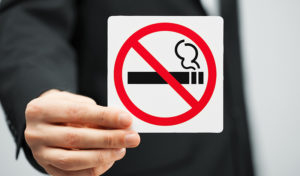Despite its health risks, smoking remains a huge issue for many communities. But can a board even take action and prohibit smoking in a homeowners association?
The Problem With Smoking in a Homeowners Association
A few decades ago, you could see smoking everywhere and people smoking in bars, restaurants, and even parks. Fast forward to today, and smoking is prohibited in most public places. State and local governments have slowly but surely taken action against smoking to mitigate the health risks related to the act.
Similarly, many homeowners associations don’t allow smoking in common areas. And there are several reasons more HOAs are following suit (if they haven’t already).
1. Secondhand Smoke
 The principal reason homeowners associations restrict smoking is due to the health concerns related to secondhand smoke. Before the 1980s, people thought that smoking only really affected the health of smokers.
The principal reason homeowners associations restrict smoking is due to the health concerns related to secondhand smoke. Before the 1980s, people thought that smoking only really affected the health of smokers.
But, thanks to a Surgeon General’s report, the hazards of exposure to secondhand smoke became public knowledge. According to the CDC, there is an increased risk of lung cancer, coronary heart disease, and stroke among non-smoking adults exposed to secondhand smoke.
Because of this, residents of an HOA often wish to avoid living next to or being in shared spaces with smokers. This is even more apparent in condominiums or multi-family dwellings, where units are close to one another. Smoke can travel through ventilation systems, plumbing, electrical lines, and even cracks in the walls. If someone smokes on their balcony, secondhand smoke can find its way to the adjacent units.
2. Fire Hazard and Higher Insurance Rates
Smoking is a fire hazard — it’s as simple as that. Homeowners aren’t perfect and can accidentally fall asleep while smoking or leave lit cigarettes everywhere. If it comes into contact with a flammable object, it can quickly become a problem.
Moreover, an HOA that does not restrict smoking may be subject to higher insurance rates. Providers are wary of fire hazards and are more likely to hike up fire insurance premiums for a community that is more prone to fires. And this is one way smoking can indirectly affect an association’s finances and budget.
3. Effects on Property
 Finally, smoking can have long-lasting and irreversible effects on property. Secondhand smoke can discolor walls and flooring, and it can also leave an unpleasant odor on upholstery. Over time, the residue can even damage property.
Finally, smoking can have long-lasting and irreversible effects on property. Secondhand smoke can discolor walls and flooring, and it can also leave an unpleasant odor on upholstery. Over time, the residue can even damage property.
In common areas, this can invite all sorts of problems. When assets deteriorate prematurely, the association will be forced to pay for repairs and maintenance earlier than planned. And while it is easy to put off these repairs until the HOA can pay for them, delays can negatively affect curb appeal and property values.
Can an HOA Restrict Smoking?
Many state and local governments already prohibit smoking in public places and workplaces, and most businesses are free to disallow smoking at their discretion. That said, the law isn’t as clear regarding smoking in non-public spaces, such as in an HOA community.
Homeowners associations can generally prohibit smoking in common areas. These are spaces open to all residents of the community (and their guests) and, sometimes, even the general public. And HOAs usually have the authority to enact a no-smoking rule in these spaces because they have control over them, akin to enacting a no-running policy in the swimming area.
It is also common for an HOA to ban smoking altogether. Whatever the case, though, if an HOA wishes to enact smoking restrictions, it must do so according to the proper procedures.
Enacting Restrictions Against Smoking in Community Associations
The cleanest way to enact a smoking restriction is by including it in the governing documents upon the creation of the association. However, not all developers have the foresight to write such a restriction into the declaration. Additionally, many communities were formed very early, when smoking was not a polarizing issue.
For HOAs that already exist, there are two ways to enact a smoking restriction. The first way is by adopting a new rule through a board resolution. This method is the easiest because it only requires a majority vote of approval from the board. But, it is not as effective in terms of enforcement because owners are much less likely to comply with a policy in which they do not have a say.
The second and, by far, the best way to adopt a smoking restriction is by amending the CC&Rs or declaration. Amending the word typically requires the membership’s approval through a vote. Depending on state laws or the governing documents, approval would either mean getting a simple or super majority or a unanimous vote. Keep in mind that not all associations have to go through a vote to amend the declaration, but most do.
Amending the declaration is more effective in terms of enforcement. This is because owners are allowed to have a say in the matter. When an amendment passes, they are more likely to honor it because it is what most homeowners want.
But amendments take time and effort and can also be quite expensive due to lawyer’s fees. The process involves many steps, ending with the recordation of the amendment with the county recorder’s office.
Smoking as a Nuisance
Almost all associations have a nuisance clause within their governing documents, which prohibits actions and activities deemed a nuisance. Many HOA boards enforce a no-smoking policy under the nuisance clause, counting smoking as an activity it covers.
While this can be effective, the problem is that most nuisance clauses could be more specific in language. It is difficult to determine to what degree smoking becomes a nuisance, and specificity is important if an HOA wishes to enforce a smoking restriction under the nuisance clause. Ambiguous provisions are harder to implement and often encounter more pushback.
Enforcing Rules on Smoking in a Homeowners Association
 Once an HOA has smoking restrictions in place, consistent enforcement is paramount. The HOA board must enforce its smoking rules fairly and uniformly. When a board enforces a restriction selectively or arbitrarily, members can argue that the restriction is no longer enforceable. And most courts will agree with this argument.
Once an HOA has smoking restrictions in place, consistent enforcement is paramount. The HOA board must enforce its smoking rules fairly and uniformly. When a board enforces a restriction selectively or arbitrarily, members can argue that the restriction is no longer enforceable. And most courts will agree with this argument.
Depending on the authority of your board, enforcement typically involves a few steps. It usually begins with the board sending a warning letter to the offender, asking them to cease. But, some boards don’t have this step and go straight to sending a violation notice. This notice should include the details of the violation and an opportunity for a hearing.
The next step is to hold a disciplinary hearing for the offender. At this point, the offender can present their argument and any evidence supporting it. The board will then have to make a decision based on the hearing. This decision is usually made in writing and sent to the offender.
The board can either lift the violation or uphold it, following it up with disciplinary action. Depending on state laws and the declaration, disciplinary action typically comes in the form of a monetary fine or temporary suspension of privileges.
The Bottom Line
At first glance, smoking in a homeowners association seems difficult to understand. But, when it comes down to it, associations generally have the power to restrict smoking. Whether or not such a restriction is right for your community depends on your board.
Clark Simson Miller offers reliable HOA management services to community associations. Call us today at 865.315.7505 or contact us online to learn more!
RELATED ARTICLES:
- Should Fireworks In An HOA Be Allowed or Banned?
- Is Running An HOA Home Business Allowed?
- Should Raising Backyard Chickens In HOA Communities Be Allowed?

